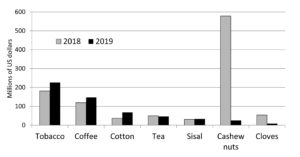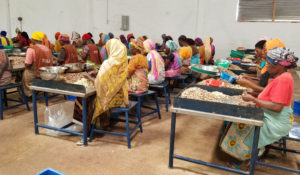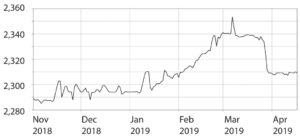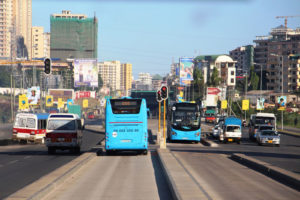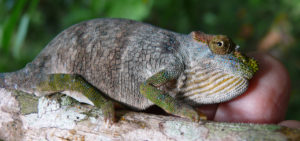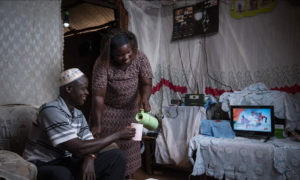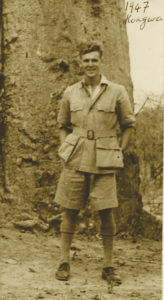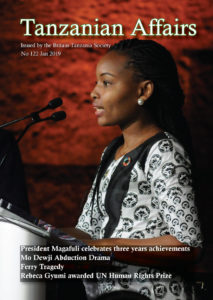by Martin Walsh
TAKEN FOR A RIDE: GROUNDING NEOLIBRALISM, PRECARIOUS LABOUR, AND PUBLIC TRANSPORT IN AN AFRICAN METROPOLIS. Matteo Rizzo. Oxford University Press, Oxford, 2017. xx + 216 pp. (hardback). ISBN 978-0-19-879424-0. £55.
Much like Matteo Rizzo, one of the most abiding memories of my first trip to Dar es Salaam (in 2006) was the seemingly endless network of patched-up, dilapidated minibuses emblazoned with colourful messages (that I was unable to understand at the time). And yet Taken for a Ride gives the reader a chance to demystify the mass transportation system in Tanzania’s major port and commercial city, and should appeal to anyone with a passing interest in major conurbations in sub-Saharan Africa.
This book draws on rich ethnographic accounts over at least seven separate periods of fieldwork, between 1998 and 2014. It goes into forensic detail to offer a rich historical tapestry of the provision of transport in Dar es Salaam. This begins with a discussion of the socialist period after Tanzanian independence (1961), and subsequently outlines the impact of the deregulation of what was previously a tightly regulated, state-run transport system in 1983. An explosion of private alternatives to cover an unmet demand saw the emergence of the daladala (minibus) system, a significant focus of the book.
One of the more impressive aspects of this book is that it manages to situate the opening up of transport in Dar es Salaam in two ways: 1) as part of the broader global ascent of neoliberalism, and 2) as part of the more specific political economy of Tanzania. For example, argues Rizzo, the speeding and overloading of daladala is a result of deregulation, as well as the economic reality of exploitation of bus workers by bus owners who demand high fees and leads the former to work very long hours. Yet a lack of viable employment alternatives leads Rizzo to connect this specific discussion of transport workers in Dar es Salaam to Mike Davis’ famous text Planet of Slums (2006) and his description of urbanisation in the Global South as marked by the creation of ‘cities without jobs’ (p. 3).
Rizzo’s historical overview also demonstrates that while daladala provide a vital service in light of chronic shortages in public transport provision by the state, they serve to question the neoliberal logic that favours private operators in unregulated markets. The process of deregulation, of course, went far beyond the transport system and represents a broader shift in Tanzanian political economy during the 1980s. Rizzo, however, goes beyond generic analysis by ‘grounding neoliberalism’ within the specific context of public transport provision in Dar es Salaam. It is noteworthy that the book concludes with a discussion of the Bus Rapid Transit Project, a recent public-private initiative that presents the latest attempt to change the dynamics of transport in Dar es Salaam.
Aside from the specifics of the transport system, Rizzo also details the complexities of labour mobilisation and the different class positions and identities held by drivers, conductors and fare collectors within daladala. While each of the chapters remain refreshingly concise, they still offer incisive analysis of: the differential experiences and related class positions of bus owners and workers; successes and failures of unionisation; and the specific and varied work trajectories of daladala workers. Rizzo sees the main contribution of the book is ‘the investigation of how “classes of labour” fare in the context of bus public transport’ and in order to do so he draws from what he describes as ‘undogmatic Marxist work on informal labour’ (p. 14).
The deliberate emphasis on the material and the economic realities of the transport network and its workers, and the laudable commitment to Marxist analysis perhaps leaves a rich period of longitudinal ethnographic research underexplored. This also leads to a bit of ‘straw man’ argument when it comes to the discussion of postcolonial theory, obscuring some the contributions made to the discussion of African cities that are not always divorced from material reality (especially in the work of Achille Mbembe). Not only does the text ‘ground’ neoliberalism, but it also emphasises a truly ‘grinding’ set of economic realities for most people in Dar es Salaam today. Indeed, I wholeheartedly embrace Rizzo’s general view that being exploited by (global and local) forms of capitalism is generally preferable to being excluded.
This book contributes a great deal to broader discussions about the politics of labour, informal economies, and class formation in African cities and is embedded and specific to the context of Dar es Salaam. While clearly an academic text, this is an easy book to read and will be of interest to a wide audience. It is a ‘must read’ for anyone engaging in urban life in Africa, and especially in Tanzania.
Rob Ahearne
Rob Ahearne is a Senior Lecturer in International Development at the University of East London. He has years of experience of living and working in the Mtwara region of southern Tanzania. He first spent a year there in 2006-07, where he helped to establish a small NGO working closely with three rural primary schools. He conducted fieldwork in Mtwara region in 2009-10 and was awarded a PhD at the University of Manchester in 2011 for a study of alternative life histories among older people. Rob has continued to conduct research in southern Tanzania, with a focus on incipient processes of natural gas extraction. He has published in various academic journals and regularly contributes pieces about contemporary Tanzanian politics to The Conversation.
TRACES OF THE FUTURE: AN ARCHAEOLOGY OF MEDICAL SCIENCE IN AFRICA. Paul Wenzel Geissler, Guillaume Lachenal, John Manton and Noémi Tousignant (editors). Intellect Books, Bristol, 2016. 256 pp. (hardback). ISBN 978-1-78320-725-1. £21.50.
Material studies, African history, and medical anthropology merge in this unique text, which is best be described as an archaeology of colonial biomedical research and futures in sub-Saharan Africa. Historians and anthropologists who study Africa have tended to engage with healing, medicine and bioethics in one of two ways: through stories of imposed colonial medical knowledge and systems on African societies or through the entanglements of Western-style medicine and traditional African healing in modern therapeutics. This volume is different, even playful, in that it successfully treats the material debris of, and present memories about, colonial medical programmes and projects to reflect on time, temporality, past failures, and contemporary disenchantment.
The book further addresses how underemphasised sources – materials and reflections from interviews – can make intimate and powerful stories that imbricate the past, present, and future to grapple with the metaphorical excavation of “past futures”. By doing so, the editors and contributors confront standard academic ways of knowing the world that emphasise linear histories dependent on purely archival sources. What they discover is what many archaeologists have known for some time: that materials (including their durability and wear), when considered alongside other historical sources, help to democratise pasts (contra the top-down perspective of French historian Pierre Nora) and to collapse time on itself (so there is a presence of many times at once).
The lead section of the book (pp. 9-38) outlines the volume’s theoretical foundations and its approach. To achieve the collective goal, the editors and authors articulate five case studies, one each from Cameroon, Nigeria, Kenya, Senegal, and Tanzania. They build collages of evidence from architectural ruins, laboratory equipment from the 20th century, formal texts, field notes, interviews, and photographs. From this, they make narratives that are intended to elicit emotions about ‘progress’ and life-and-death in the tropics. The book is an interrogation of time and power, à la Imperial Debris: On Ruins and Ruination, a well-regarded book edited by Ann Laura Stoler.
The lieux de mémoire captured by the authors of Traces of the Future subverts Nora’s treatments by bringing into clear relief Africans’ expectations of modernity across a tumultuous period. In Traces, most interviewees frame colonial medicine as a failed intervention. In many ways, the overall volume is illustrative of “dark heritage”. Its primarily visual orientation, including numerous glossy colour photographs, helps the reader to understand medical research and bioethics in Africa during the period from the 1940s to the1960s. In addition, and perhaps more importantly, the chapters motivate the audience to reflect in affective ways on the roles that states, institutions, and scientists (may) play in past and future vulnerabilities.
The chapter on Amani Hill Research Station in northeast Tanzania addresses how the site’s roles and representations of it have been appropriated and negotiated through time up to the present. From 1902 onward, the Amani facility was shaped by German, French, Soviet, East African, and then Tanzanian influences and interests. Past African participants and their descendants hold conflicting memories of it as a symbol of potential decolonised futures where Africanised medicine was anticipated to better meet the needs of patients and citizens. Images of dilapidated buildings and objects – as if frozen in time – in ruined laboratories at Amani accompany documents intended to elicit emotion and stir reflection in the reader. As the authors demonstrate well, material traces carry forward glimpses of stories to be renegotiated in present and future circumstances. These traces also often become the subject of rumour and innuendo.
The editors and authors of this chapter and the whole volume accomplish their goals, but there are also some concerning discordances and absences. It is worth considering whether the text treats objects as the perfect postcolonial subject, in that materials are interpreted in a way that validates the interpretations of Western-trained scholars. Why, instead, is there not a more substantial engagement meaningfully linking materials to people? The two primary types of sources – materials and oral reflections – in most instances seem to be overly disconnected rather than more fully entangled. Does this tendency in practice replicate a colonial gaze instead of critiquing it?
Two other observations deserve mention. It is unfortunate that the book does not quote more from archaeologists who work in Africa, and especially Africans who are archaeologists. There is a substantial global literature on entanglements among materials, memories, temporalities, and futures authored by archaeologists, including Shannon Lee Dawdy, Joost Fontein, Webber Ndoro, Ferdinand De Jong, and Alfredo González-Ruibal. Secondly, it is interesting that the historians and anthropologists who guide the volume promote “being with the past”. Archaeologists have long practised their craft in this manner. They work on landscapes, interact with people and materials, and so forth, while historians have tended to remain in archives, often never visiting the places or communities which they write about.
In fact, “archaeology” was considered a bad word among historians decades ago, including in the History Department at the University of Dar es Salaam. To Marxist historians there, archaeology was not considered a topic that engaged the present and future needs of Tanzanians. Moreover, in general archaeology was treated as a handmaiden to history. During the last two decades, historians and cultural anthropologists have begun to recognise the importance of materials to remake historical interpretations and representations from more inclusive perspectives.
In Traces of the Future, colonial science and its future orientation take on new meanings under changed circumstances in five areas of the continent. Under the deft artistry of the editors and authors, readers will realise the potential role of contemporary archaeology to dig deep in an era of disenchantment.
Jonathan R. Walz
Jonathan R. Walz, PhD, is Associate Professor and Graduate Program Chair at the SIT-Graduate Institute in Vermont, USA. His scholarly interests include the history and anthropology of eastern Africa and the Indian Ocean. He is currently stationed in Zanzibar, where he leads graduate and undergraduate programmes on human livelihoods, coastal ecology, and climate change.
Also noticed: THE SWAHILI WORLD. Stephanie Wynne-Jones and Adria LaViolette (edi
tors). Routledge, London and New York, 2018. xxv + 672 pp. (hardback). ISBN 978-1-138-91346-2. £136.
Let me begin by declaring an interest: I received a copy of this doorstopper because I contributed one of its numerous chapters. I’ll therefore confine this unsolicited notice to a broad outline of its contents and a few additional observations.
According to the publisher’s enthusiastic blurb, “The Swahili World presents the fascinating story of a major world civilisation, exploring the archaeology, history, linguistics, and anthropology of the Indian Ocean coast of Africa. It covers a 1,500-year sweep of history, from the first settlement of the coast to the complex urban tradition found there today. […] This is the first volume to explore the Swahili in chronological perspective. Each chapter offers a unique wealth of detail on an aspect of the region’s past, written by the leading scholars on the subject. The result is a book that allows both specialist and non-specialist readers to explore the diversity of the Swahili tradition, how Swahili society has changed over time, as well as how our understandings of the region have shifted since Swahili studies first began.” And that’s just an extract.
The introductory chapter by the editors, archaeologists Stephanie Wynne-Jones and Adria LaViolette, is followed by 55 others. Part I, “Environment, background and Swahili historiography”, comprises seven chapters including discussions of Swahili identity, genetic ancestry, and the early history of the Swahili language. Part II, “The Swahili Age”, is divided into sections on “Origins and early emporia”, “Swahili urbanism”, “Daily life”, “Trade and connectivity”, “Objects of exchange”, and “Swahili architecture”. While some of the 36 chapters in this part of the book are thematic, others deal with particular locations, including different settlements on the Tanzanian coast and islands. The third and final part, “The early modern and modern Swahili coast”, includes 12 chapters, divided between sections on “Colonial domination and the rise of Zanzibar” and “The contemporary coast”.
The Swahili World is one of a series of such tomes in the “Routledge Worlds” series. The publication of large multi-authored collections of this kind is a growing trend. Although the original recommended retail price was a wallet-shrinking £170, new hardback copies can now be bought online at not much over a third of this price, and the e-book is cheaper still. This is still a lot of money, and I must admit that one of my incentives for contributing to volumes like this is so that I don’t have to pay for them. The book was actually in my hands at the start of November 2017: Routledge, like other commercial publishers, have adopted the annoying practice of forward-dating so that their books seem to be hot off the press even as they are cooling down. Nevertheless, I’m looking forward to reading it.
Martin Walsh
Martin Walsh is the Book Reviews Editor of Tanzanian Affairs.
